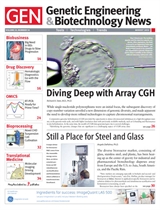Aug 22 2013
Researchers at the Institute of Cancer Research in London have discovered a genetic variant that influences the aging process among four new variants they linked to myeloma. The study more than doubles the number of genetic variants associated with myeloma, bringing the total number to seven.
The research, published in Nature Genetics on Sunday, was mainly funded by the charities Leukaemia & Lymphoma Research and Myeloma UK, with additional support from Cancer Research UK.
One genetic marker found by the researchers is linked to a gene called TERC, which regulates the length of the telomere caps on the ends of DNA. In healthy cells, these caps erode over time, causing tissues to age. However, some cancer cells seem able to ignore the aging trigger in order to keep on dividing. If further studies confirm the link, TERC could be a target for future myeloma treatments.
The team found the new markers by comparing the genetic makeup of a total of 4,692 myeloma patients with DNA from 10,990 people without the disease. A previous U.K. study led by the team uncovered three genetic variants that lead to increased risk of developing myeloma. All of the four new genetic variants are close to genes that are likely to play important roles in causing myeloma.
In people affected by myeloma, plasma cells grow uncontrollably in the bone marrow and become stuck there, disrupting normal blood production. It can be very painful, and affects bones in multiple parts of the body.
"The identification of these risk gene variants offers more compelling evidence that susceptibility to myeloma can be inherited. Myeloma remains incurable, and the effect on patients' quality of life can be devastating," said Prof. Chris Bunce, research director at Leukaemia & Lymphoma Research. "By showing how these specific genes influence the cancer's development, this research could potentially lead to the development of targeted myeloma drugs in the future. In addition we know that a common condition called MGUS [monoclonal gammopathy of undetermined significance] predisposes to the development of myeloma. The identification of additional genetic risk factors in these patients could revolutionize their future management and prospects."
  This article was reprinted from Genetic Engineering & Biotechnology News (GEN) with permission from Mary Ann Liebert, Inc., publishers. Genetic Engineering & Biotechnology News (GEN) has retained its position as the number one biotech publisher around the globe since its launch in 1981. GEN publishes a print edition 21 times a year and has additional exclusive editorial content online, like news and analysis as well as blogs, podcasts, webinars, polls, videos, and application notes. GEN's unique news and technology focus includes the entire bioproduct life cycle from early-stage R&D, to applied research including omics, biomarkers, as well as diagnostics, to bioprocessing and commercialization. This article was reprinted from Genetic Engineering & Biotechnology News (GEN) with permission from Mary Ann Liebert, Inc., publishers. Genetic Engineering & Biotechnology News (GEN) has retained its position as the number one biotech publisher around the globe since its launch in 1981. GEN publishes a print edition 21 times a year and has additional exclusive editorial content online, like news and analysis as well as blogs, podcasts, webinars, polls, videos, and application notes. GEN's unique news and technology focus includes the entire bioproduct life cycle from early-stage R&D, to applied research including omics, biomarkers, as well as diagnostics, to bioprocessing and commercialization. |